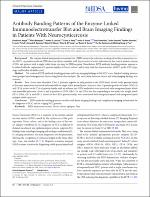| dc.contributor.author | Pretell, Edwin Javier | |
| dc.contributor.author | Arroyo, Gianfranco | |
| dc.contributor.author | Rodriguez, Silvia | |
| dc.contributor.author | Lescano, Andrés | |
| dc.contributor.author | Alroy, Karen A. | |
| dc.contributor.author | Bustos, Javier | |
| dc.contributor.author | Santivañez, Saul | |
| dc.contributor.author | Gonzales, Isidro | |
| dc.contributor.author | Saavedra, Herbert | |
| dc.contributor.author | Gonzalez, Armando | |
| dc.contributor.author | Gilman, Robert H. | |
| dc.contributor.author | Tsang, Victor C. W. | |
| dc.contributor.author | García, Hector H. | |
| dc.date.accessioned | 2019-03-27T21:54:10Z | |
| dc.date.available | 2019-03-27T21:54:10Z | |
| dc.date.issued | 2018-01 | |
| dc.identifier.citation | Clinical Infectious Diseases. 2018; 66. | es_PE |
| dc.identifier.uri | https://hdl.handle.net/20.500.12959/82 | |
| dc.description.abstract | Background. The enzyme-linked immunoelectrotransfer blot (EITB) assay is the reference serological test for neurocysticercosis (NCC). A positive result on EITB does not always correlate with the presence of active infections in the central nervous system
(CNS), and patients with a single viable brain cyst may be EITB negative. Nonetheless, EITB antibody banding patterns appears to
be related with the expression of 3 protein families of Taenia solium, and in turn with the characteristics of NCC in the CNS (type,
stage, and burden of viable cysts).
Methods. We evaluated EITB antibody banding patterns and brain imaging findings of 548 NCC cases. Similar banding patterns
were grouped into homogeneous classes using latent class analysis. The association between classes and brain imaging findings was
assessed.
Results. Four classes were identified. Class 1 (patients negative or only positive to the GP50 band, related to the protein family
of the same name) was associated with nonviable or single viable parenchymal cysticerci; class 2 (patients positive to bands GP42–39
and GP24, related to the T24-42 protein family, with or without anti-GP50 antibodies) was associated with intraparenchymal viable
and nonviable infections; classes 3 and 4 (positive to GP50, GP42-39, and GP24 but also responding to low molecular weight bands
GP21, GP18, GP14, and GP13, related to the 8 kDa protein family) were associated with extraparenchymal and intraparenchymal
multiple viable cysticerci.
Conclusions. EITB antibody banding patterns correlate with brain imaging findings and complement imaging information for
the diagnosis of NCC and for staging NCC patients. | es_PE |
| dc.description.abstract | El ensayo de inmunoelectrotransferencia ligada a enzimas (EITB) es la prueba serológica de referencia para la neurocisticercosis (NCC). Un resultado positivo en EITB no siempre se correlaciona con la presencia de infecciones activas en el sistema nervioso central (SNC), y los pacientes con un único quiste cerebral viable pueden tener EITB negativo. Sin embargo, los patrones de bandas de anticuerpos EITB parecen estar relacionados con la expresión de 3 familias de proteínas de Taenia solium y, a su vez, con las características de NCC en el SNC (tipo, estadio y carga de quistes viables).
Métodos
Evaluamos los patrones de bandas de anticuerpos EITB y los hallazgos de imágenes cerebrales de 548 casos de NCC. Se agruparon patrones de bandas similares en clases homogéneas mediante análisis de clases latentes. Se evaluó la asociación entre las clases y los hallazgos de las imágenes cerebrales.
Resultados
Se identificaron cuatro clases. La clase 1 (pacientes negativos o solo positivos a la banda GP50, relacionada con la familia de proteínas del mismo nombre) se asoció con cisticercos parenquimatosos no viables o únicos viables; la clase 2 (pacientes positivos para las bandas GP42-39 y GP24, relacionadas con la familia de proteínas T24-42, con o sin anticuerpos anti-GP50) se asoció con infecciones intraparenquimatosas viables y no viables; las clases 3 y 4 (positivas para GP50, GP42-39 y GP24, pero que también respondieron a las bandas de bajo peso molecular GP21, GP18, GP14 y GP13, relacionadas con la familia de proteínas de 8 kDa) se asociaron con múltiples cisticercos viables extraparenquimatosos e intraparenquimatosos.
Conclusiones
Los patrones de bandas de anticuerpos EITB se correlacionan con los hallazgos de las imágenes cerebrales y complementan la información de las imágenes para el diagnóstico de NCC y para la estadificación de los pacientes con NCC. | |
| dc.format | application/pdf | es_PE |
| dc.language.iso | eng | es_PE |
| dc.publisher | Infections Diseases Society of America | es_PE |
| dc.relation.uri | https://academic.oup.com/cid/article/66/2/282/4103069 | |
| dc.rights | info:eu-repo/semantics/openAccess | es_PE |
| dc.rights.uri | https://creativecommons.org/licenses/by-nc-nd/4.0/ | es_PE |
| dc.source | Seguro Social de Salud (EsSalud) | es_PE |
| dc.source | Repositorio Institucional EsSalud | es_PE |
| dc.subject | Parasitología | es_PE |
| dc.subject | Neurocisticercosis | es_PE |
| dc.subject | Epilepsia | |
| dc.subject | Neurocysticercosis | |
| dc.subject | Taenia solium | |
| dc.subject | Epilepsy | |
| dc.title | Antibody banding patterns of the enzyme-linked immunoelectrotransfer blot and brain imaging findings in patients with Neurocysticercosis. | es_PE |
| dc.type | info:eu-repo/semantics/article | es_PE |
| dc.subject.ocde | https://purl.org/pe-repo/ocde/ford#3.05.00 | es_PE |
| dc.publisher.country | PE | es_PE |
| dc.identifier.doi | https://doi.org/10.1093/cid/cix774 | |






